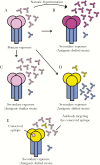Immunodominance and Antigenic Variation of Influenza Virus Hemagglutinin: Implications for Design of Universal Vaccine Immunogens
- PMID: 30535315
- PMCID: PMC6452323
- DOI: 10.1093/infdis/jiy696
Immunodominance and Antigenic Variation of Influenza Virus Hemagglutinin: Implications for Design of Universal Vaccine Immunogens
Abstract
Influenza viruses routinely acquire mutations in their hemagglutinin (HA) and neuraminidase (NA) glycoproteins that abrogate binding of pre-existing antibodies in a process known as antigenic drift. Most human antibodies against HA and NA are directed against epitopes that are hypervariable and not against epitopes that are conserved among different influenza virus strains. Universal influenza vaccines are currently being developed to elicit protective responses against functionally conserved sites on influenza proteins where viral escape mutations can result in large fitness costs [1]. Universal vaccine targets include the highly conserved HA stem domain [2-12], the less conserved HA receptor-binding site (RBS) [13-16], as well as conserved sites on NA [17-19]. One central challenge of universal vaccine efforts is to steer human antibody responses away from immunodominant, variable epitopes and towards subdominant, functionally conserved sites. Overcoming this challenge will require further understanding of the structural basis of broadly neutralizing HA and NA antibody binding epitopes and factors that influence immunodominance hierarchies of human antibody responses.
Keywords: antibody response; immune imprinting; influenza virus; vaccine design; virus evolution.
© The Author(s) 2019. Published by Oxford University Press for the Infectious Diseases Society of America. All rights reserved. For permissions, e-mail: journals.permissions@oup.com.
Figures


Similar articles
-
Headless hemagglutinin-containing influenza viral particles direct immune responses toward more conserved epitopes.J Virol. 2024 Oct 22;98(10):e0116624. doi: 10.1128/jvi.01166-24. Epub 2024 Sep 26. J Virol. 2024. PMID: 39324791
-
Mutations in the Hemagglutinin Stalk Domain Do Not Permit Escape from a Protective, Stalk-Based Vaccine-Induced Immune Response in the Mouse Model.mBio. 2021 Feb 16;12(1):e03617-20. doi: 10.1128/mBio.03617-20. mBio. 2021. PMID: 33593972 Free PMC article.
-
Universal Influenza Vaccine Approaches Using Full-Length or Head-Only Hemagglutinin Proteins.J Infect Dis. 2019 Apr 8;219(Suppl_1):S57-S61. doi: 10.1093/infdis/jiz004. J Infect Dis. 2019. PMID: 30715379
-
Implications of broadly neutralizing antibodies in the development of a universal influenza vaccine.Curr Opin Virol. 2016 Apr;17:110-115. doi: 10.1016/j.coviro.2016.03.002. Epub 2016 Mar 28. Curr Opin Virol. 2016. PMID: 27031684 Free PMC article. Review.
-
Novel universal influenza virus vaccine approaches.Curr Opin Virol. 2016 Apr;17:95-103. doi: 10.1016/j.coviro.2016.02.002. Epub 2016 Feb 27. Curr Opin Virol. 2016. PMID: 26927813 Free PMC article. Review.
Cited by
-
Breathing and Tilting: Mesoscale Simulations Illuminate Influenza Glycoprotein Vulnerabilities.ACS Cent Sci. 2022 Dec 28;8(12):1646-1663. doi: 10.1021/acscentsci.2c00981. Epub 2022 Dec 8. ACS Cent Sci. 2022. PMID: 36589893 Free PMC article.
-
Mucosal correlates of protection after influenza viral challenge of vaccinated and unvaccinated healthy volunteers.mBio. 2024 Feb 14;15(2):e0237223. doi: 10.1128/mbio.02372-23. Epub 2024 Jan 9. mBio. 2024. PMID: 38193710 Free PMC article.
-
A comprehensive influenza reporter virus panel for high-throughput deep profiling of neutralizing antibodies.Nat Commun. 2021 Mar 19;12(1):1722. doi: 10.1038/s41467-021-21954-2. Nat Commun. 2021. PMID: 33741916 Free PMC article.
-
Multivalent next generation influenza virus vaccines protect against seasonal and pre-pandemic viruses.Sci Rep. 2024 Jan 16;14(1):1440. doi: 10.1038/s41598-023-51024-0. Sci Rep. 2024. PMID: 38228649 Free PMC article.
-
Protein Nanoparticle-Mediated Delivery of Recombinant Influenza Hemagglutinin Enhances Immunogenicity and Breadth of the Antibody Response.ACS Infect Dis. 2023 Feb 10;9(2):239-252. doi: 10.1021/acsinfecdis.2c00362. Epub 2023 Jan 6. ACS Infect Dis. 2023. PMID: 36607269 Free PMC article.
References
-
- Krammer F, Palese P. Advances in the development of influenza virus vaccines. Nat Rev Drug Discov 2015; 14:167–82. - PubMed
-
- Impagliazzo A, Milder F, Kuipers H, et al. . A stable trimeric influenza hemagglutinin stem as a broadly protective immunogen. Science 2015; 349:1301–6. - PubMed
-
- Yassine HM, Boyington JC, McTamney PM, et al. . Hemagglutinin-stem nanoparticles generate heterosubtypic influenza protection. Nat Med 2015; 21:1065–70. - PubMed
Publication types
MeSH terms
Substances
Grants and funding
LinkOut - more resources
Full Text Sources
Other Literature Sources
Medical

